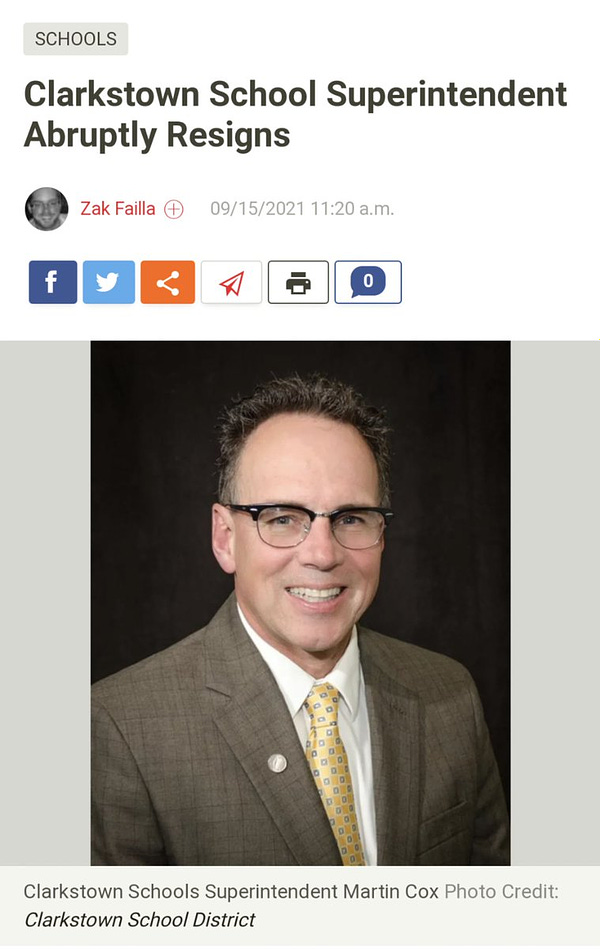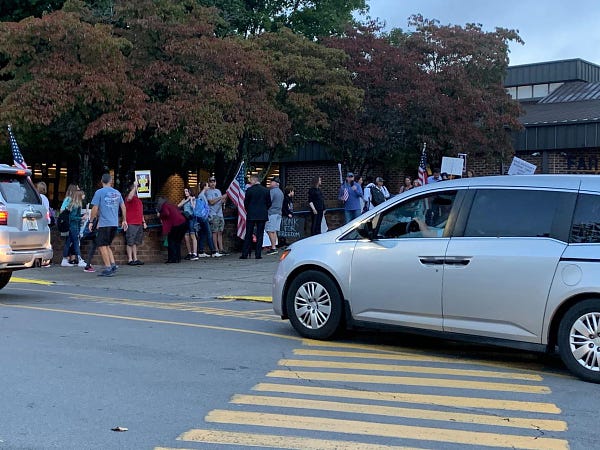Some cheered when Martin Cox, a School Superintendent in New York State was forced out by his school board. Conservative activist Chris Rufo called it an example of “the heart of democracy”


Breitbart and other conservative websites ran stories based on Rufo’s tweet. The cause for celebration? Dethroning an elitist bureaucrat who had forced radical ideas on an unwilling community.
But look more closely, and that narrative starts to fall apart. Instead, Cox looks like a lot of other school officials these days, struggling to satisfy different stakeholders – parents, students, state officials – who imposed competing demands on how he should run his schools. Some parents were mad about mask requirements in the classroom. Students complained that Cox had cancelled a BLM explainer, and thus was not sufficiently progressive. The most compelling reported evidence of his Critical Race Theory heresies was of Cox following State Board of Regent recommendations to create a Diversity, Equity and Inclusion taskforce. To be sure, there may have been other offenses we don’t know about, but the public record is inconsistent with the narrative. The School Board agreed to pay Cox a generous $400,000 exit package that required a nondisclosure agreement, an outcome that seems unlikely if he had engaged in actual wrongdoing.
Big takeaway: the culture wars are making the management of public education not just hard but impossible, and giving school officials less discretion to manage irreconcilable conflicts
Whatever else he was, Cox was not the unaccountable bureaucrat from on high. He was also not alone. A popular school principal in Texas was removed after a former school board candidate alleged he had trafficked in CRT. Again, evidence of wrongdoing was thin. The School Board denied it was about CRT but offered no real specifics beyond generalities such as the principal was “dividing large portions of the community.” A Tennessee high school coach was fired after a parent complained about his discussion of racism, specifically for assigning a Ta-Nehisi Coates essay that analyzed the centrality of race to Trump’s popularity.
In the last few months, school officials across the United States have experienced a wave of laws that restrict what they can teach or how they manage a public health crisis, angry school board meetings, open-records requests, and in some rare cases, suspensions or firings, and even intimidation and threats. It is easier to document the scale of some of these trends more than others, but there is an unmistakable sense of more intense conflict around our schools.
Some demands on schools comes from progressives, especially the push for more explicit discussion of race in school. School officials who defy progressive values might face threats, such as a school board that sought to limit a free school lunch program in Wisconsin. Teachers unions are also a stakeholder that can make the lives of school administrators more complex. But the current pressures seem to be mostly a right-wing phenomenon, with greater intensity of feeling, extreme tactics, and organization of purpose on the conservative side, cultivated by right-wing media, think-tanks, and the Republican Party.
The net effect of these processes will be to reduce the professional autonomy of school officials, making it harder for them to do their jobs.
Making Hard Jobs Impossible
In a classic book about public organizations, Erwin Hargrove and John Glidewell argue that some public jobs are not just difficult – they are impossible. Unlike their private counterparts, public managers are obliged to be responsive to democratic concerns rather than market concerns. But they can’t do their job when stakeholders fundamentally disagree about the goals of the organization. Jobs also become impossible when public confidence in the public official’s profession is low.
Culture war issues are making public jobs more impossible by reducing consensus about key goals and eroding public confidence in professional skills. The result is that public officials are given less room to do their work, instead spending their time and energy in a pinball machine of irreconcilable conflicts and accountabilities. This expansion of the conflict zone to public services extends beyond education. See also examples from public health and election administration.
Expanding the zone of conflict means using culture war techniques (intimidation, threats), as well as standard tools of political organization and control (elections, bills restricting speech or public health actions, directives on books or curriculum).
For example, this Tennessee school faced protests for students masking.


Or this protest at a school board member’s house

In Florida, a state where school officials are banned from requiring students to wear masks to limit the spread of pandemic, some school board members received threats and Nazi imagery in the mail.


Democracy in Action?
One view of what is happening is that this is simply parents taking control of their kid’s schools. In other words, it’s just democracy in action. Public schools are public institutions after all.
But there are some important caveats to this view. First, democracy implies representativeness. A long-standing concern in studies of citizen participation is that the most active participants tend not to be representative. Thus, it seems reasonable to assume that the type of people who turn up at school meetings, protest at school official’s homes or impose open record requests are often not representative. Many are movement activists, and some do not even have kids in schools. For example, anti-mask protestors in Beverly Hill don’t have to reflect the broad wishes of the local community to make life difficult for parents, children and staff.

Second, the point of democracies is to prevent certain types of conflict. When things slide into threats of violence and intimidation, that is not a healthy democracy. Things have gotten bad enough that the Attorney General issued a memo warning against threats to school personnel.
Third, and this is the topic I am going to some time on, public services balance democratic oversight with bureaucratic action. This is partly because the public recognizes its limitations in professional domains. So, we offer broad direction on goals to bureaucracies, and then delegate how they are implemented. All too often, those goals are competing – improve test scores! develop young citizens! well-rounded students! – which enhances the need to provide autonomy to officials to deal with tradeoffs and conflicts. Giving every aggrieved stakeholder a never-ending veto on how public work is done makes it impossible to do public work.
Achieving Democratic Goals Requires Some Expertise
In general, public organizations granted more autonomy perform better, and we tend to delegate more autonomy to organizations when we view its members as holding professional expertise. To take an extreme example, people aren’t trying to assert more democratic control over the National Weather Service. Schools are different, partly because our kids are there, and partly because some people don’t think teaching is a real profession involving specialized knowledge and skills. Maybe you think would do a perfectly fine job as teacher. Many people homeshcool and do just fine. I’d caution, however, that homeschooling the kid you’ve known since birth is fundamentally a different task from managing a classroom of diverse kids, their parents and the bureaucracy that comes with it.
Much of the current debate is about whether people view education as a profession, and are willing to grant education professionals some autonomy to do their job
The tension between expertise and political control is hardly new. A classic version of it was articulated by President Andrew Jackson: “The duties of all public officers are, or at least admit of being made, so plain and simple that men of intelligence may readily qualify themselves for their performance; and I can not but believe that more is lost by the long continuance of men in office than is generally to be gained by their experience.” This Jacksonian populism has returned, very much echoed in contemporary populist efforts to politicize public services today.
And as with Jackson, the motivation is partly to diminish centers of power viewed as at odds with populist control. Today, school teachers are framed as elites, at least partly because they are associated with unions that tend to oppose Republicans. When I lived in Wisconsin, Scott Walker’s program to destroy public sector unions presented teachers as part of the groups of “haves” leeching from the “have nots”, reflecting what political scientist Katherine Cramer labeled the politics of resentment.
Attacks on school officials also reflect a broader anti-intellectual sentiment that disparages higher education, and the schools of education that produce teachers as particular as hotbeds of radical thought. [Full disclosure, I know a number of school of education faculty. Sometimes I’ve been to their houses, poked around in their stuff while pretending to go to the bathroom, interrogated their kids. If they are Marxists, they are engaging in deep cover that makes The Americans look like amateurs].
Of course, parents have a right to protect their kids from radical ideas and practices. But is that what they are actually doing? If it was, there would first have to be a large educational conspiracy to espouse Marxism, the dark tenets of the Franklin School, and Critical Race Theory. And frankly the evidence of such a conspiracy has not been presented to the degree that explains the response we are seeing. It’s clear in many cases that the transgressions used to justify curtailing professional autonomy fall far short of the alleged assault on American values.
Instead, we have created a climate of panic where anyone can make a claim of grievance that is either unfounded or unreasonable. Many will instictively support this claim without considering the (lack of) evidence or giving teachers the benefit of the doubt, and putting pressure on school officials to act.
Lets take some more examples:
· In Southlake, Texas, a 4th grade school teacher was reprimanded for giving a copy of “This Book Is Anti-Racist” to a student. The school district cleared her of wrongdoing, but the school board punished her anyway. This is the same school district where school board members lost elections when the administrators responded to student demands to introduce diversity training after a viral video showed students using the N word.
· In Missouri, a state legislator called on a State Superintendent to be fired after a teacher gave students an optional student exercise asking them to analyze art by Walt Whitman, Childish Gambino, Woody Guthrie or Langston Hughes.
· The sponsor of a bill banning CRT in Wisconsin declared that it was illegal to use terms like diversity, equity, inclusion, systemic racism, or social justice. Another legislative supporter of the bill said: “I don’t want school professionals to make decisions about teaching and learning.”
· In Yorktown, PA, an all-white school board emailed teachers telling them they could not use a vast list of books touching on issues of race, including a book about Rosa Parks and a memoir by Malala Yousafzai. After protests, the board reversed itself. But book bans are popping up elsewhere.
· In Rhode Island, the parent of an incoming kindergartener made “over 200 public records requests in two months, seeking copies of middle and high school curricula, lists of all books related to gender available in the library and 10 years worth of harassment complaints and emails. The district said it would take 300 hours to compile all of the records requested.” One school official described it as a tactic “to shut the system down... I believe their intent is really to have the public lose confidence in public education.”
· An anti-CRT law in Texas prohibits teachers for incorporating civic activity in the classroom. And so teachers have stopped assignments like asking students to attend and takes notes at public meetings, write letters to lawmakers, or have removed credit from students participating in civic engagement programs.
It’s hard to imagine what would justify this sort of backlash, but the case simply hasn’t been made.
As a result, school officials are subject to more constraints about teaching, and harsher punishments for wrongthink. School officials who worry that their emails will be misrepresented become less willing to communicate frankly. They fear lawsuits from new legal coalitions alleging that they are infringing on student rights. Time spent responding to open records requests eat up finite resources.
Teachers worried about being attacked may choose not to press their students to address issues they believe they would benefit from, or assign certain books. Such actions are likely to have chilling effects that reflect the existing power structure. In conservative areas this means tiptoeing around white feelings. If you teach about history, civics, US studies, art, or if you engage in discussions about the deeper context of contemporary events that center on race, your hands are tied.
Putting Schools in the Zone of Conflict Will Undermine their Ability to Achieve Core Goals
Democracies ask public officials to achieve multiple and sometimes competing goals. Maximizing one means reducing performance on another. Over the last few decades, bipartisan democratic processes, such as the No Child Left Behind Act, Race to the Top, and Every Student Succeeds Act, supported by a broad educational reform movement, have fundamentally altered the job of teaching, telling school officials to focus on student academic performance.
How big is the nature of this change? As recently as 1989, James Q. Wilson offered schools as an example of “coping” organizations: that is, public organizations where the actions and results of teacher effort were hard to observe. Once the teacher shut the door, there is little that the school principal or broader community could do to monitor them. And so, the best strategy was to hire really good people and let them at it.
That is very much not how we think of schools today. We have shifted to a logic of individualized responsibility where we assume that test metrics and econometric tools like value-added modeling are valid measures of teacher performance. Teachers can keep or lose their jobs based on such metrics, which are often visible to the public. For example, the LA Times publishes the value-added scores of individual teachers. There is no reasonable way to claim that these teachers are not more accountable to democratic processes than their peers a generation ago.
The anti-CRT community argues we should be surveilling school officials in other domains, specifically their fealty to certain forms of political thought. The anti-mask and anti-vaxx brigade want to punish school officials for trying to protect employees, kids and broader communities while facing a pandemic and changing public health guidelines.
We should worry about this. Conservatives tend to forget that Jacksonian politicization of public services ushered in an era of poor public sector performance. Cross country studies show that in general, more autonomy for educational officials is associated with higher academic performance. Grants of autonomy makes school officials better able to focus on performance goals, core administrative tasks, tailoring solutions to local needs. Finland’s strong performance is often brought up by the education reform movement. Teaching there is a high-status profession where schools are given room to operate as professionals.
What’s the point of all this?
From a historical point of view, conservative backlash against schools is not new, incorporating not just teaching on race, but also evolution, sex education, gender and sexual preferences. In the long-run, such efforts have been largely unsuccessful in reversing the leftward shift on key views. Cross-time estimates of racial views show a public less tolerant of explicit racism, with a similar shift in views about gender, and gay rights. The reason why discussion of race may be becoming more prominent in schools, and elsewhere, is that more and more members of the public are ready to have those discussions. Educators are not swimming against the popular tide.
But perhaps that’s not the point of a culture war backlash. Maybe the real goal is political mobilization, creating a salient wedge issue. One point of support for this possibility is that two seemingly unrelated issues are working in tandem to motivate activist attacks on education: the anti-vaccine and anti-mask groups (a public health issue) and the anti-CRT groups (an issue centered on teaching about race). What these movements have in common is a general alignment with a conservative ideological wolrdview.
The organizational element of this movement is also easy to observe, where resources, tactics and strategies are shared among activists. One such activist who had submitted dozens of open-record requests described it as “a war with the left.” The focus on organizing such attacks by well-funded think tanks like the Heritage Foundation reinforce the sense that the goal of the movement is to benefit Republicans in elections, and recruit the next generation of political activists.
This political mobilization is not costless if it undermines the quality of public education. Making schools a culture war zone will make it harder to recruit talented teachers, school leaders, and board members, and distracts their attention from core educational goals. After all, who signs up to be called “Marxists, racists, Nazis and child abusers”?
Of course, dysfunction is a feature, not a bug, if you see public institutions as fundamentally broken. Chris Rufo has promoted the anti-CRT movement as a means for conservatives to “take some of these essentially corrupted state agencies and then contest them, and then create rival power centers within them.” That might be good for conservative politics, but it’s probably bad for the quality of our public institutions.


